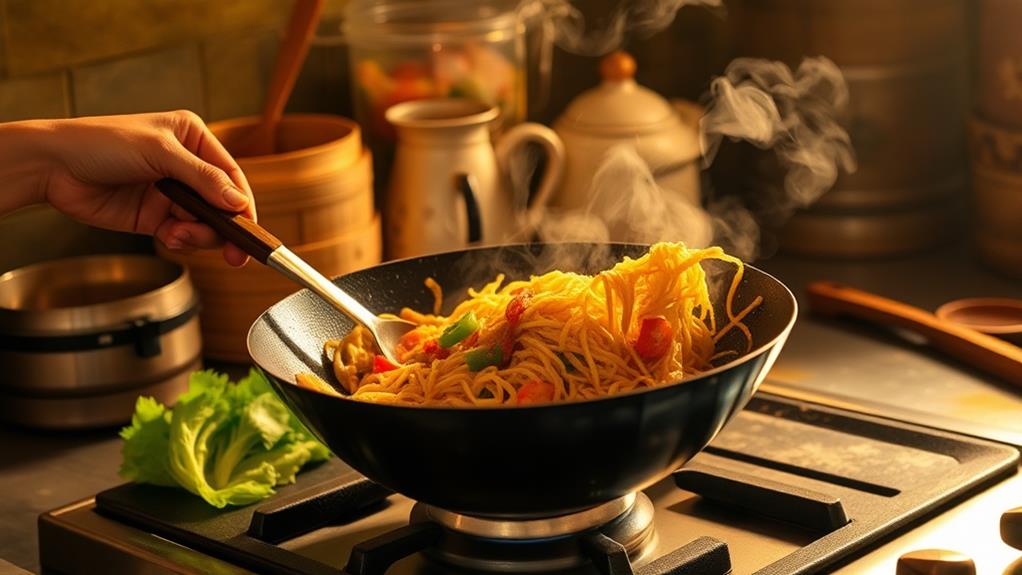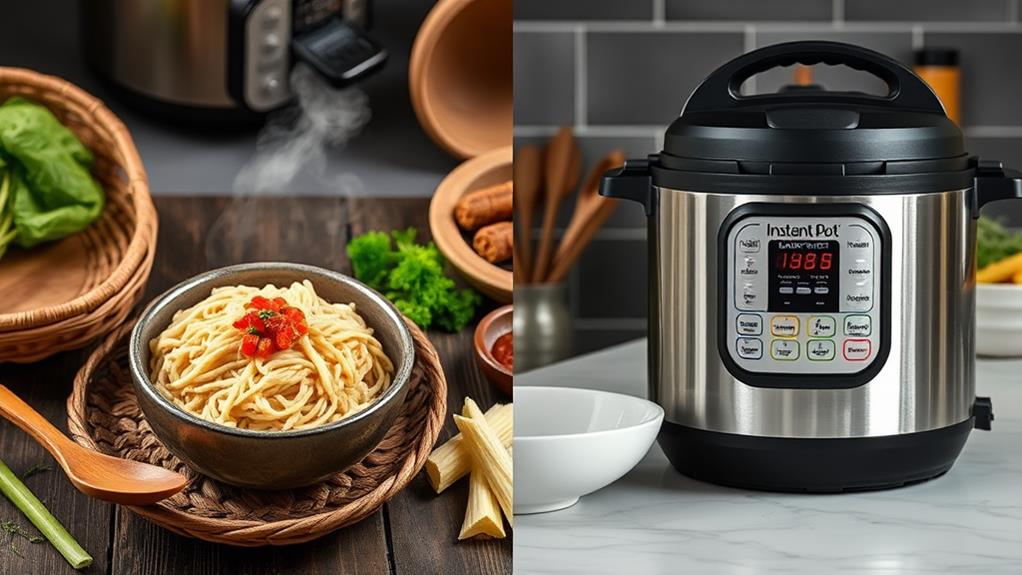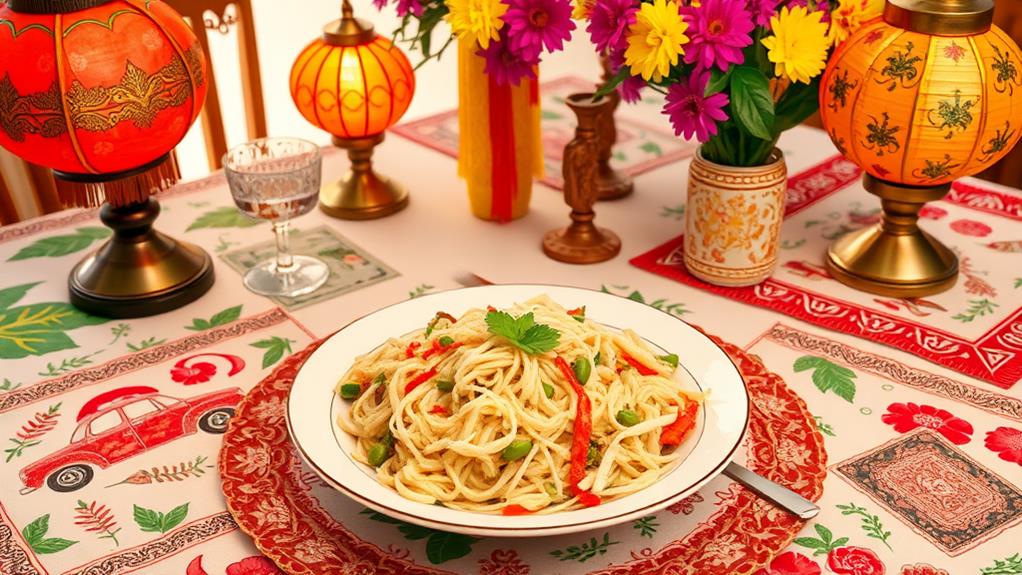Pancit rice noodles have been a staple in Filipino cuisine for centuries, proudly reflecting the country's rich cultural heritage. This dish was introduced by Chinese immigrants in the 9th century, and over time, it has become an integral part of Filipino celebrations, strengthening family and community ties through shared meals.
Pancit showcases the country's cultural adaptability, blending Chinese culinary techniques with Filipino flavors and traditions. For example, in the Philippines, pancit is often served with a sweet and savory sauce, which is a distinct Filipino twist on the traditional Chinese dish.
Regional variations of pancit exist, each with its own unique flavor profile and cooking style. For instance, Pancit Bihon, a popular variation, uses thin rice flour noodles and is often served with vegetables and meat or seafood.
Pancit is a nutritious dish, rich in complex carbohydrates, fiber, and protein. It is also low in calories and fat, making it a healthy option for those looking for a balanced meal.
Pancit symbolizes long life, good fortune, and community bonding in Filipino culture. During special occasions, such as birthdays and weddings, pancit is often served to celebrate long life and good fortune.
In addition, the act of sharing a meal of pancit with family and friends strengthens community bonds and fosters a sense of togetherness.
History and Cultural Significance

Pancit rice noodles have been an integral part of Filipino cuisine for centuries. Introduced by Chinese immigrants in the 9th century, pancit has evolved into a beloved staple.
This dish reflects the cultural significance of food in Filipino celebrations, where sharing meals strengthens bonds within families and communities.
Traditionally, pancit is served during special occasions, especially birthdays, where longer noodles symbolize long life and good fortune. This tradition highlights the importance of food in Filipino culture, reinforcing values of hospitality and togetherness.
The fusion of Chinese culinary techniques with Filipino flavors has resulted in a unique and delicious dish that showcases the country's rich cultural heritage.
Through pancit, you'll experience the warmth and generosity of the Filipino people, where food isn't just a source of sustenance, but a symbol of love, respect, and community.
Key Ingredients and Variations
Pancit's core ingredients include bihon noodles, proteins, and vegetables. These thin rice vermicelli noodles absorb flavors from various ingredients and sauces. Typically, Pancit recipes feature proteins like chicken, pork, and shrimp, accompanied by a mix of colorful vegetables such as carrots, cabbage, and snap peas. This combination creates a nutritious and visually appealing dish.
Regional variations of Pancit abound, showcasing local ingredients and culinary traditions. For example, Pancit Canton features thicker egg noodles and a chewier texture, while Pancit Palabok uses thicker rice noodles and is served with a savory shrimp sauce.
The use of soy sauce, oyster sauce, calamansi juice, and chicken bouillon contributes to the rich, savory flavor profile characteristic of Filipino cooking. These variations reflect the country's diverse culture and culinary traditions.
Cooking Techniques and Methods

Mastering Pancit Cooking Techniques
Mastering the art of cooking Pancit requires attention to detail and a solid understanding of its unique cooking techniques and methods.
Soaking noodles in warm water makes them soft and pliable, preventing breakage during stir-frying. A wok is the ideal cooking vessel because its design allows for even heat distribution and high-heat stir-frying, which develops the flavors and gives the noodles a slight char.
Gradual Liquid Addition
When cooking Pancit, gradually add chicken stock or broth to ensure the noodles absorb moisture without becoming soggy. This technique helps maintain the noodles' texture and prevents them from becoming mushy.
Cooking Vegetables and Proteins
Add vegetables towards the end of the cooking process to retain their crunch and vibrant colors. Stir-fry the ingredients quickly over medium-high heat to prevent overcooking, maintaining the natural flavors and textures of the proteins and vegetables.
This technique helps preserve the nutrients and color of the ingredients.
Achieving a Perfectly Cooked Pancit
Nutritional Value and Benefits
Pancit Bihon as a Source of Energy and Nutrients
A serving of Pancit Bihon, approximately 286 calories, provides a moderate source of energy and essential nutrients.
As a gluten-free Filipino food, it's suitable for individuals with gluten intolerance or celiac disease.
Carbohydrates and Fiber Content
Pancit Bihon is rich in carbohydrates, with approximately 31 grams per serving, serving as a primary energy source.
The dish also contains dietary fiber from the vegetables, which aids in digestion and overall health.
Vitamins, Minerals, and Protein Content
Pancit Bihon is a good source of vitamins A and C from the vegetables.
It typically contains around 15 grams of protein per serving, depending on the choice of meat or tofu used, which supports muscle health and repair.
Nutritional Benefits
With its balanced mix of carbohydrates, protein, and fiber, Pancit Bihon is a nutritious addition to your meals, providing energy, supporting digestion, and promoting overall health.
Traditional Vs Modern Recipes

Traditional Pancit Recipes
Traditional Pancit recipes typically feature bihon (thin rice noodles) and a variety of proteins like chicken, pork, and shrimp, along with seasonal vegetables.
These recipes reflect the dish's roots in communal cooking and celebration. Soy sauce and calamansi are emphasized for flavor, and cooking is usually done in a wok using high heat for stir-frying.
Modern Pancit Recipes
In contrast, modern Pancit recipes may incorporate alternative ingredients such as gluten-free noodles or plant-based proteins, catering to contemporary dietary preferences and health-conscious consumers.
Modern recipes experiment with diverse sauces and spices, resulting in unique flavor profiles that appeal to a wider audience.
Cooking methods have adapted to modern convenience, with many recipes using Instant Pots or slow cookers to reduce cooking durations while maintaining essential flavors and textures.
Regional Differences and Specialties
Regional Variations of Pancit
Filipino cuisine is characterized by diversity, and pancit is no exception. Regional variations of pancit showcase unique twists.
Pancit Malabon in Malabon
In Malabon, thicker rice noodles are topped with seafood, reflecting the coastal influences of the area. This regional specialty, Pancit Malabon, highlights the region's flavors.
Pancit Canton in the Visayas Region
In the Visayas region, Pancit Canton takes center stage, featuring egg noodles stir-fried with a mix of vegetables and proteins.
The texture and flavor profile are distinct from bihon, highlighting the adaptability of pancit to local ingredients and culinary techniques.
Pancit Palabok
Pancit Palabok features thicker rice noodles and savory orange sauce made from shrimp and meat.
This regional specialty is a staple in many Filipino households, demonstrating the diversity of pancit across the country.
Regional Differences and National Favorite
These regional differences and specialties contribute to pancit's status as a national favorite.
Each variation tells a story of the local culture and traditions.
As you try each regional take on pancit, you'll appreciate the nuances that set them apart, while still honoring the essence of this beloved Filipino dish.
Symbolism and Celebration

Pancit: A Symbolic Dish in Filipino Celebrations
Pancit, specifically Pancit Bihon, is a staple dish in Filipino celebrations, holding a deeper meaning beyond its taste and texture. It symbolizes long life and good fortune, making it a customary feature at family gatherings and milestone events.
| Celebration | Symbolism |
|---|---|
| Birthdays | Long life and good fortune |
| Holidays | Longevity and family bonds |
| Family gatherings | Hospitality and community |
In Filipino tradition, sharing Pancit during special occasions reflects hospitality and the importance of community and togetherness. Recipes for Pancit are frequently passed down through generations, preserving cultural heritage and reinforcing familial bonds. The popularity of Pancit among the Filipino diaspora serves as a connection to their cultural identity, allowing them to celebrate their roots even when away from home. By sharing a plate of Pancit, you're not only savoring a delicious meal, but also honoring tradition and cultural heritage.
Filipino Hospitality and Sharing
Filipino hospitality is built on warmth and generosity, with food playing a central role in bringing people together. When attending a Filipino gathering, expect an abundance of food, with dishes like Pancit often taking center stage. This emphasis on food sharing stems from the cultural importance of communal bonding and celebration.
Sharing food is a cornerstone of Filipino hospitality, particularly during family gatherings and celebrations. Dishes like Pancit serve as a centerpiece, fostering a sense of community and togetherness. This tradition is rooted in the concept of "Bayanihan," a communal spirit of helping and sharing that reinforces social bonds within the community.
When served Pancit, you're not just enjoying a meal; you're experiencing the generosity and communal spirit of the Filipino people. The act of serving Pancit reflects the values of abundance and generosity that define traditional Filipino hospitality.
Adaptability and Fusion Cuisine

Pancit rice noodles embody adaptability and fusion cuisine, seamlessly blending different culinary traditions. This dish can be easily customized to suit individual taste preferences and dietary needs by incorporating various proteins such as chicken, pork, shrimp, or tofu.
Additionally, Pancit's adaptability extends to seasonal variations, allowing for the inclusion of local vegetables like cabbage, carrots, and snap peas to reflect the freshness of each preparation.
Pancit's fusion cuisine is a result of cultural blending, combining Chinese cooking techniques with Filipino flavors. This cultural fusion occurred when Chinese immigrants introduced the dish to the Philippines.
To create unique flavor profiles, Pancit can be further customized by experimenting with different sauces and seasonings, such as oyster sauce or calamansi juice.
Modern interpretations of Pancit have incorporated international flavors and ingredients, appealing to a broader audience and evolving culinary trends.
How Are Pancit Rice Noodles Used in Filipino Cuisine and What Makes Them a Staple?
Pancit rice noodles production process begins with rice flour mixed with water, then kneaded into dough and steamed. These noodles are used in a variety of Filipino dishes, such as pancit bihon and pancit canton. Their versatility and ability to absorb flavors make them a staple in Filipino cuisine.
Preserving Cultural Heritage
Pancit Preserves Cultural Heritage
Unifying People and Cultures
Pancit's cultural significance lies in its ability to bring people together during family gatherings and celebrations, symbolizing long life and prosperity. This is evident in the way Pancit is often served at cultural events, fostering a sense of community and togetherness.
Preserving Traditional Cooking Methods
The dish has become an integral part of Filipino culture, and its recipes are often passed down through generations, preserving traditional cooking methods and family ties.
This cultural heritage is also reflected in the regional variations of Pancit, which showcase local ingredients and cooking styles while still honoring the foundational elements of the dish.
A Connection to the Homeland
Pancit serves as a connection to the homeland for the Filipino diaspora, allowing them to share their culture and culinary heritage with others.
This is especially important for those living abroad, as it provides a sense of comfort and familiarity.
Maintaining Filipino Identity
The popularity of Pancit abroad helps maintain the Filipino identity and cultural heritage, promoting cross-cultural understanding and appreciation.
Frequently Asked Questions
Why Is Pancit Important to the Filipino Culture?
Pancit's significance in Filipino culture stems from its embodiment of the country's rich history, cultural importance, and social connections.
This iconic dish has been a staple in Filipino gatherings and celebrations, showcasing regional variations in cooking techniques and noodle types. For instance, the Habhab from Quezon Province is made with rice flour noodles, while the Pancit Bihon from the Visayas region uses rice stick noodles.
Pancit represents the nation's culinary heritage, symbolizing long life and prosperity. The dish's diverse ingredients reflect the country's cultural roots, with influences from Chinese, Spanish, and Malay cuisines.
Sharing a plate of pancit isn't only a delicious meal but also a way to honor the country's cultural roots and foster togetherness.
Is Pancit a Staple Food?
Pancit is a staple food in Filipino culture. This is evident in its rich history and diverse variations. Throughout the Philippines, pancit is often served at festivals and celebrations, solidifying its importance in Filipino traditions.
The dish's versatility in ingredients and preparation has contributed to its widespread popularity.
Countless recipes have been created, catering to local tastes and ingredients. Moreover, pancit offers various health benefits, making it a staple in many Filipino households and communities worldwide.
Why Does Pancit Symbolize Long Life?
In Filipino culture, pancit symbolizes long life because of its long, uncut noodles, which represent longevity and prosperity. This cultural significance is rooted in the importance of food traditions in family gatherings and celebratory dishes.
For instance, during birthdays and special occasions, serving pancit is believed to bring good fortune and a long, healthy life to the celebrant.
The origins of pancit's ingredients and regional variations have blended with Filipino culinary heritage, reinforcing beliefs about longevity and festive occasions. The dish's Chinese origins, combined with local ingredients and cooking techniques, have created a unique Filipino tradition.
This blend of cultural influences has solidified pancit's role in Filipino celebrations, where it's often served as a symbol of good luck and long life.
What Type of Cuisine Is Pancit?
Pancit is a diverse category of noodle dishes with various types, including rice flour and egg noodles. The differences in cooking methods, ingredient substitutions, and flavor profiles across regions result in unique pancit dishes.
Historical origins from Chinese cuisine have blended with Filipino cultural influences, making pancit a staple in local celebrations and gatherings.
Pancit's adaptability is evident in its presentation styles, health benefits, and serving occasions, which have cemented its place in Filipino cuisine.
